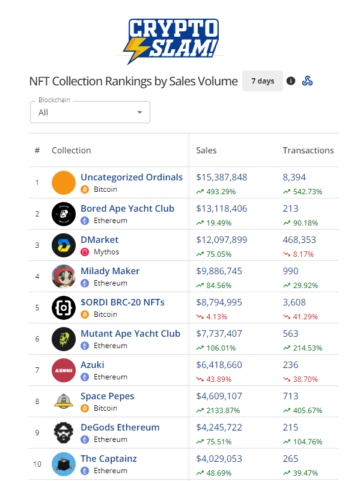In this issue
- Tornado Cash: Heavy weather
- Cardano: Upgrade delayed
- Canaan: Can-do
From the Editor’s Desk
Dear Reader,
“Shaken, not stirred” is the way the world’s favorite British secret service agent likes his martinis mixed. This week, it’s the way some in the crypto world are feeling.
As if the seemingly interminable crypto winter weren’t enough for them, crypto libertarians in the Netherlands have been sufficiently shaken up to mount a demonstration against the arrest of Alexey Pertsev, a developer who has been linked to the mixer Tornado Cash.
Tornado Cash is a cause célèbre for a certain section of the crypto community, but it’s also a means of concealing fund flows that hadn’t sat well with regulators since they first heard of Bitcoin and the alarm was raised over the prospect that cryptocurrencies were a conduit of criminality.
The whole point of crypto mixers is to obscure money trails so they’re difficult to trace back to their original sources — the same way money movements in the fiat world can be secreted behind shell companies. Both have legitimate uses, but both are also tools used to hide things. And Tornado Cash’s alleged use by North Korea’s Lazarus hacking group will only add to the political pressure to rein it in — alongside other crypto mixers.
If the digital asset industry has learned one thing over the years, it’s that if it wants to be taken seriously and thrive, it had better get right with regulators, who — rest assured — will be relentless in their pursuit of wrongdoing, and whose capabilities for cracking down on it are constantly improving.
The mission remains: How does innovation thrive while seeking first to be understood? It’s a question we’ll be exploring this week at our Crypto Rising virtual event, where we’ll examine the future of regulation for the digital asset sector in Asia-Pacific and beyond. There needs to be more consistency in the crypto conversation worldwide — I dare say there’s currently little of that. But things could — and should — be changing. The world still needs saving, 007.
Until the next time,
Angie Lau,
Founder and Editor-in-Chief
Forkast.News
1. Gathering storm


By the numbers: Tornado Cash — over 5,000% increase in Google search volume.
More than 50 demonstrators gathered in Amsterdam last weekend to protest against the arrest of Alexey Pertsev earlier this month over his alleged involvement with Tornado Cash, a crypto mixer recently sanctioned by U.S. authorities.
- Pertsev, a 29-year-old blockchain developer, was arrested on Aug. 10 in the Netherlands on suspicion of “involvement in concealing criminal financial flows and facilitating money laundering through the mixing of cryptocurrencies” via Tornado Cash. Pertsev is currently in custody but has not been charged with any criminal offense.
- The U.S. Department of the Treasury’s Office of Foreign Assets Control (OFAC) sanctioned Tornado Cash on Aug. 8 for being suspected of having been used to launder more than US$7 billion in cryptocurrencies since 2019, including over US$455 million that allegedly had been stolen by the North Korean state-backed Lazarus hacking group. Aside from adding Tornado Cash to its Specially Designated Nationals blacklist, the U.S. banned “U.S. persons” from using its services.
- Tornado Cash is an Ethereum-based crypto mixer founded in 2019 to promote privacy and anonymity in the crypto space. Cryptocurrency mixers allow users to send crypto into a large pool of crypto from other sources, with which it is mixed, and withdraw the same amount, minus a fee, that obscures the origin of the tokens. Tornado Cash’s services protect the privacy of legitimate transactions but can also be used to hide criminal activity.
- Since OFAC acted, the price of Tornado Cash’s TORN token has dropped from around US$30 to US$9, according to CoinMarketCap.
- Crypto mixers’ involvement in money laundering has recently drawn attention from regulators. According to a recent report by SlowMist, a blockchain security firm, hackers responsible for stealing US$610 million of crypto from Axie Infinity’s Ronin bridge five months ago have already changed most of their Ether loot into Bitcoin using renBTC and privacy tools such as Blender, ChipMixer and TornadoCash.
- Pertsev’s arrest has raised concerns among open-source software developers over the vulnerability of their trade. The protest in Amsterdam’s Dam Square at the weekend was initiated by decentralized finance aggregator 1inch Network. “Is it really a crime to be an open-source #blockchain developer nowadays?” the company tweeted. “Developers have no control whatsoever over how their code is subsequently used.”
Forkast.Insights | What does it mean?
U.S. regulators have long expressed annoyance at the existence of crypto mixer services, and in May imposed their first-ever sanctions against one of them, Blender.io. The crackdown on Tornado Cash is part of ongoing American efforts to stop North Korea’s state-sponsored crypto hackers from swapping stolen crypto for cash to help prop up the regime of the country’s leader, Kim Jong Un.
But in taking action, OFAC has raised difficult questions about the very nature of decentralized networks. The regulator’s intervention is targeting validators in an attempt to force them to refuse transactions from Tornado Cash. Although many in the Ethereum community have vowed not to comply with the demand, the infrastructure upon which many validators depend won’t necessarily back them up.
Estimates suggest that more than half of all nodes maintaining Ethereum make use of Amazon Web Services. In January last year, AWS kicked far-right social network Parler off its servers over its role in spreading hate speech. AWS did so not because it was compelled by law enforcement, but because Parler’s actions were held to have violated the company’s terms of service. If OFAC comes knocking on Amazon’s door, it seems unlikely that AWS would put up much resistance.
2. Testing times


By the numbers: Cardano testnet failure — over 5,000% increase in Google search volume.
Cardano’s testnet was said to be “catastrophically broken” last week, raising additional doubts over the launch of the blockchain’s long-delayed Vasil hard fork, despite founder Charles Hoskinson’s rejection of ongoing concerns.
- Adam Dean, a Cardano ecosystem developer, offered the bleak characterization on Twitter last week, pointing to a bug in Cardano node v1.35.2 that would cause “incompatible forks.” Dean suggested that the bug was a product of Cardano’s rush to implement the Vasil fork, and urged its developer, Input-Output Global to deploy tools for a testnet disaster recovery.
- Cardano has been criticized for being slower to develop than other smart-contract blockchains, such as Ethereum and Solana, but the project dismisses such concerns, citing its “slow and steady wins the race” approach.
- Cardano is a public, decentralized proof-of-stake blockchain that aspires to be the next generation of Ethereum. Its native token, ADA, is currently the eighth-largest cryptocurrency by market cap. ADA was trading at US$0.46 at the press time, down more than 15% since Dean’s tweet, according to CoinMarketCap.
- In response to the bug, Cardano released new client software Cardano Node v1.35.3 on two separate testnets. According to Dean, however, v1.35.3 is also “incompatible and incapable of syncing the chain.”
- Input-Output Global Chief Executive Hoskinson responded that the coding issue had been thoroughly fixed in v1.35.3, and expressed frustration at the blame being laid on Cardano’s testnet issues and a possible delay of the Vasil hard fork.
- “We of course could, as a community, delay the launch of Vasil for a few months to retest code that’s already been tested a dozen times and is already running,” Hoskinson tweeted. “Is that worth it to all the dApp (decentralized app) developers who have been waiting for this update for almost a year now?”
- Hoskinson also appeared to ask the network’s critics for understanding, tweeting that Cardano had “a fragmented approach to ecosystem development and no accountability structures outside of catalyst to force more rapid and sustainable adoption,” but offered no hint of whether there would be further delays to the Vasil upgrade.
- Implementing a blockchain hard fork involves splitting a new, upgraded blockchain from the original. Cardano’s Vasil hard fork aims to increase throughput on the Cardano network and improve the development experience for smart-contract and dApp developers. The upgrade was originally due to launch in June, but has been postponed twice due to bugs and what Input-Output Global’s head of delivery and projects has described as “an abundance of caution.”
Forkast.Insights | What does it mean?
Upgrading cryptocurrency networks is notoriously difficult. Ethereum’s timetable for upgrading its network frequently slips, and some updates have been postponed for more than a year. There are two key reasons for this.
The first is technical. The complexity of blockchains creates a number of “attack vectors” for hackers to exploit, meaning that any upgrade has to be strenuously tested before it can be deployed.
The second reason blockchains are so hard to upgrade is due to governance. Because blockchains, for the most part, are designed not to be run by a centralized entity, gaining consensus is notoriously difficult. That means discussions on upgrades can last for months, if not years, slowing a blockchain’s development to a crawl.
But even if consensus is reached, network upgrades often require validators and miners to hard-fork a network to run a new version of the software that underpins it. This isn’t as simple as it sounds. Bitcoin’s network is littered with nodes not running the most up-to-date software, further compounding the network’s ability to upgrade itself.
Cardano is finding this out firsthand. To outsiders, this appears concerning. For insiders, it’s business as usual.
3. Canaan rakes it in


Bitcoin prices may be slumping and energy rates soaring, but crypto mining rig builder Canaan’s income for the second quarter of this year was more than 50% up compared to Q2 2021.
- The Beijing-based mining machine maker raked in 1.65 billion yuan (US$246.7 million) in revenue during the quarter, a 52.8% year-on-year increase, according to the company’s latest earnings report.
- Canaan was founded and is led by Nangeng (NG) Zhang, who launched the world’s first cryptocurrency mining rig powered by application-specific integrated circuit (ASIC) chips. ASIC mining has become the Bitcoin production method favored by many mining businesses.
- The Bitcoin mining industry suffered throughout the second quarter as Bitcoin prices, the main source of miners’ revenue, went from intra-period peaks of more than US$47,000 in Q1 to under the US$20,000 mark.
- Canaan’s earnings contrast with that of other crypto miners in North America, which posted big losses in the same quarter. Marathon Digital Holdings recorded a net loss of US$191.6 million in Q2, and Hut 8 booked a net loss of C$88.1 million (US$67.9 million).
- Canaan expects its total net revenue for Q3 to be less than in Q3 2021, but it is still advancing plans for expanding in North America, including building new warehouses and opening more repair centers. Canaan is also exploring opportunities to set up additional mining operations in North America, Zhang said on an earnings call.
Forkast.Insights | What does it mean?
Ongoing heatwaves and droughts have led to power outages in some parts of China, prompting many factories in the southwestern province of Sichuan to halt operations, which has hurt the world’s second-largest economy.
Sichuan, a province with abundant hydropower generation resources, was one of the world’s largest hubs for crypto miners before China imposed a blanket ban on mining last year. The mining ban, however, did not extend to the mining rig manufacturing sector, and Canaan continues to operate from its headquarters in Beijing.
But as many Chinese miners have moved out of China since China’s ban came into effect, there’s an inevitability about Canaan following suit. Last year, Canaan set up its first repair service center outside of China in Kazakhstan, a neighboring country that many Chinese crypto miners had fled to. Canaan Senior Vice President Edward Lu told Forkast in a recent interview that the mining hardware giant had also been eyeing the U.S. mining market and planned to build warehouses and maintenance facilities to support expected growth in mining operations there.
But are Canaan’s U.S. expansion plans now under a cloud? Canaan Chief Executive Nangeng (NG) Zhang is now warning that the company’s performance would come under pressure in the coming one to two quarters. He said on an earnings call last week that lower Bitcoin prices and rising energy costs were “seriously impacting” demand among miners for computing power, and that they would continue to do so “for some time in the future.”
Lu, nonetheless, appears to remain optimistic about the outlook for the industry, telling Forkast that the crypto winter may be shorter than expected and that the company’s revenue was driven mainly by long-term partnerships with large, institutional clients that were also “well prepared” for market downturns.
The Nasdaq-listed mining rig maker has repeatedly said it’s positioned to weather a challenging environment, but that didn’t stop it from predicting a third-quarter revenue slump of 17% to 32% from the same period the previous year. It remains to be seen how Canaan’s U.S. expansion plans will play out with the market headwinds facing the company.
- ADA - Cardano
- Bitcoin
- blockchain
- blockchain compliance
- blockchain conference
- BTC - Bitcoin
- canaan
- Cardano
- coinbase
- coingenius
- Consensus
- Crime
- crypto conference
- crypto mining
- cryptocurrency
- Decentralization
- decentralized
- DeFi
- Digital Assets
- ethereum
- Forkast
- machine learning
- Mining
- non fungible token
- plato
- plato ai
- Plato Data Intelligence
- Platoblockchain
- PlatoData
- platogaming
- Polygon
- proof of stake
- Tornado Cash
- W3
- zephyrnet













